Advertisement - Introduction
Are you planning to promote your newly started business OR just want to buy a new smart phone?Are you looking for the best university for your higher education OR just hunting for a career counselling institution?Are you looking for a bride/bridegroom for your marriage OR just hunting a holiday spot?
Whatever your requirement is (of such kind), the answer is −
Advertisement, Advertisement, and Advertisement,

In today’s world, all of us are under the influence of ‘Advertisement’. Right from buying groceries to children’s study materials, finding a holiday spot to watching a movie, selecting restaurant for dinner to booking a banquet hall for special events, and searching educational institutions to hunting for a company to find jobs, almost every act is guided and decided by advertisements.
What is an Advertisement?
Advertisement (ad) is an efficient and effective technique to promote goods, services, and ideas. It is a paid form of non-personal communication wherein business information is made available for potential customers.
Advertisement, is derived from the Latin word “Advertere” which literally means “to turn the minds of … towards…”. Advertisement promotes and supplements selling of products, services, and ideas to a great extent. The most interesting part of an advertisement is – it carries factual information with fascinating emotional appeal. Hence, without a proper advertisement no business can prosper.

What is a Buzz?The literal meaning of “Buzz” is – “a low, continuous humming or murmuring sound.” In the advertising sense, it is a technique of marketing. It is getting viral these days. Buzz marketing technique relies upon the power of one-on-one personal messages.It is believed that word-of-mouth holds more weightage with consumers. Buzz marketing is perceived as an impartial form of marketing people trust the recommendations made by their relatives and friends. Social media is the most energetic vehicle of buzz marketing.
Objectives of Advertisements
The fundamental idea behind advertisement is to increase the business by selling goods/services. Besides, there are many other objectives of advertisement, significant of them are −
- To promote newly launched products among the potential customers.
- To promote personal selling program.
- To create awareness among maximum people about your business in a short period of time.
- To enter national or even international market and motivate new group of customers.
- To enhance the goodwill and build credibility among the customers by promising to provide better quality of products and services.
Advertisement Process
The advertisements that we see in the newspapers, magazines, and roadside hoardings or watch on television or on the internet involves a lot of work. An advertisement goes through different stages from its initial planning stage to its execution. In addition, it also involves groups of people specialized in different fields. For example, experts of management, copyediting, creative writing, photography, videography, acting, etc.
Following are the fundamental stages to develop and execute an ad −
Typical Workflow in an Ad Agency
| Stage | Work Performed |
|---|---|
| Beginning Stage |
|
| Development Stage |
|
| Execution Stage |
|
| Post Execution |
|
Segments of Advertisement
Following are the three major sectors of Advertisements −
- Advertiser − Business organization or any other individual, who wishes to advertise their products, services, or ideas.
- Ad Agency − A service-based firm that creates innovative ideas and develops an attractive and meaningful ad.
- Media − A communication platform that offers substantial and effective medium to advertise.
Medium of Advertisement
While planning to advertise your business/product/idea, you also need to decide which medium would be the best suited to execute your ad. You can choose from multiple mediums from the list given below −
Print Media
It is one of the oldest, but still popular medium of advertisement. It includes, newspapers, brochures, magazines, and fliers. It is the low budget medium of advertisement, but the rate varies to a great extent depending upon the −
- Geographic location (city, town, etc.)
- Brand (of newspaper & magazine), and
- Space (how much & which part of the page you are booking).

Broadcast/Electronic Media
It is the most advanced and fastest media, which reaches the remotest regions of the world in a fraction of a minute.
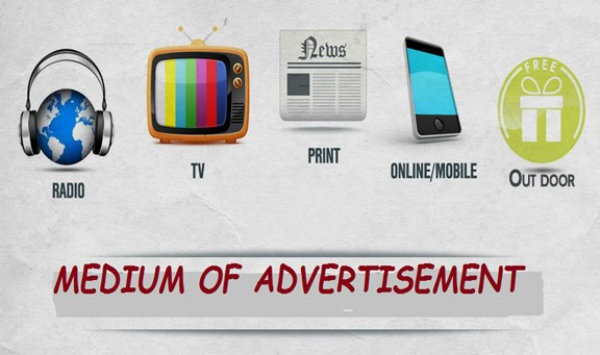
It includes radio, television, and the Internet. Since, on television and internet, both video and audio can be run; therefore, it is the most popular and effective medium.
Outdoor − It is the cheapest, but effective medium. It includes hoardings, flags, banners, billboards, motor vehicles, building/fence wraps, events, etc. Outdoor advertisement is used in various ways to increase brand awareness and for the promotion of products/services.
Check Your Progress
- What is advertisement process?
- How is advertisement the most essential feature of a business?
- What do you understand by ‘advertisement media?’
- What are the objectives of advertisement?
Advertisement Design
Some of the ads published either in the newspaper or shown on the television fascinate people instantly, despite the fact that they don’t need that product. Why?
It is only because of its beautiful design, communicative power, and fascinating execution. Thus, design is one of the most fundamental features of an ad.

What is an Advertisement Design?
There is neither a magical formula nor pre-defined rules to combine lines, colors, images, typefaces, and other graphic elements to create an eye-catching ad. However, design depends upon the requirement of the client and features, functions, appearance, and nature of the product.
Execution of a well-thought out layout and design has an impressive effect on consumers. A smartly articulated design encourages or in other words subtly compels people to buy the product.
How to Develop Creative Ad Design?
Designing is all about creative idea and creative idea is solely dependent upon the clear understanding of a project’s goal. Once the project is clear, one needs to do a little market research to understand the behavior of potential customers.
Punchline, eye-catching heading, succinct content body, and relevant image (if any required) must be figured out in advance. If you have all equipment ready with you, you can develop a creative design.
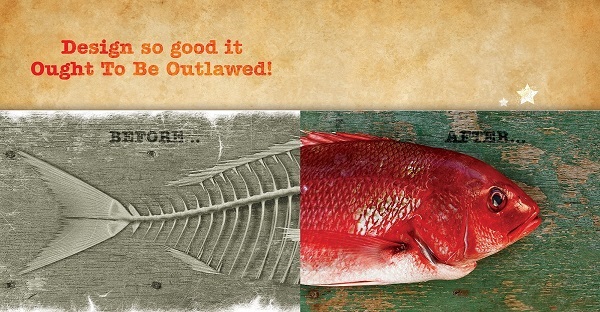
Strategy of Creative Design
A clear-cut idea and a well-defined strategy are the integral parts of a creative design. Strategy includes some of the essential components such as −
Simplicity − Try to keep the layout simple. Put large pictures on top, headline beneath that, content body in the middle, while logo and address on the right side at the bottom.
Balance − To focus on some points, you need to create a symmetry in design. The key part of creative designing is to organize all elements including images, blocks, headlines, content body, and illustration so that they seem balanced.
Proportion − The size and color of all graphic elements must be determined by their significance and surroundings of the illustration. For example, important idea, image, or design must be larger, brighter, and bolder so that it appears distinct from other elements (as shown in the image given below).
Unity − First find out the focal point of the ad where you want people to focus. Once done, highlight it as a central point by dimming the surrounding and background design and color. One point to always keep in mind is that all elements of your design - the visual language and presentation should be in unity.
Contrast − Create contrast so that it can grab people’s attention. For example, among a bunch of mango, an apple grabs attention.
Consistency − Maintain the consistency. Page to page consistency is indispensable for an eye-catching ad. It helps people understand the meaning of different elements of an ad.
Photo Design − Generally, photo attracts people first. Selection of a good photograph and placing it smartly in an ad is another smart way to grab people’s attention (see the image below).

Proximity − Proximity is one of the most significant elements of creative design. It compels people to think on the design (ad). Therefore, designing proximity is a cerebral task. For example, remember the ad Marlboro Cigarette — the mythical man, a combination of cigarette, horse, cowboy, and rustic image of the Old West. The ad was an instant hit.
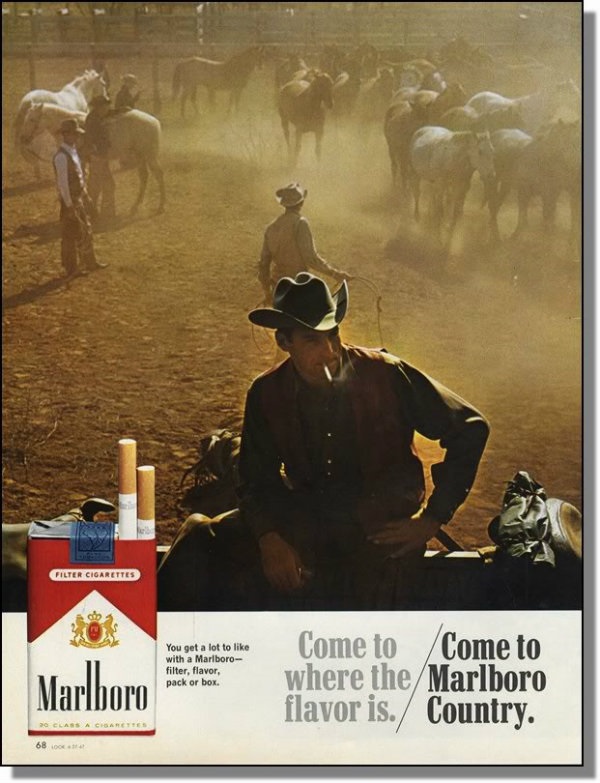
Color Design − Selection of color is also a very important task. Normally, black and white is boring, but some ads demand only black and white colors.
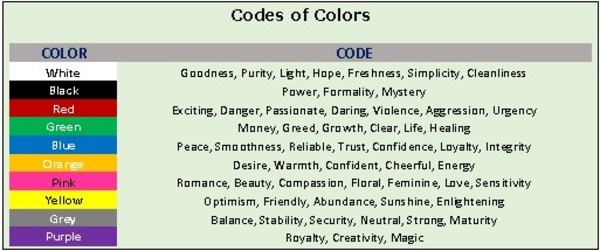
Ads which require to be colorful, needs to be designed very carefully maintaining the consistency and proportion. Excessive use of colors or excessive brightness distract people’s attention.
Design Checklist
Once an ad is developed, it should not be published without checking the following points −
- Does the ad illustrate all elements in a balanced form?
- Does the ad have all essential elements including, punchline/headline, logo, content, price, and balanced illustration?
- Does the ad make any false promises?
- Does the ad contain any deceptive element?
- Does the ad consist of clear, precise, and crisp presentation?
Check Your Progress
- What is creative design?
- How an advertisement is the most essential feature of a business?
- What do you understand by the ‘strategy of a creative design’?
- What are the points that you need to check after developing a creative design?
Campaign & Promotion
Suppose, you have one of the best products or services that you are offering on an attractive prices. But the question is – “How would I come to know about your quality products?
Campaign and promotions are the activities and technique that make your product popular among the customers.

What is a Campaign?
Campaign is a focused term that promotes targeted products/services for a short period of time. It uses various medium for communication such as pamphlets, banners, roadside stalls, events, etc.
Objectives of a Campaign
Campaign has some specific objectives, significant of them are −
- To tell people — about the launch of a new product/service.
- To tell people — where it is available.
- To tell people — at what price it is available.
- To tell people — from when and how long it would be available.
- To tell people — what are the special features of concerned product/service.
What is an Effective Campaign?
The campaign for which positive response starts coming in just after a short period of time is known as an effective campaign. To make your campaign, the most effective and result oriented, you must focus on the following aspects −
- Who − Represents the target audiences or target markets
- Where − Represents the geographical locations of your target audiences and what media vehicles you are required to reach there.
- What − Represents what messages need to be given to your target audiences.
- Why − Represents the objectives of your campaign.
- When − Represents the time schedule (availability of the product).
- How − Last, but not the least, you need to plan, how you will deploy the available resources to run your business.
Planning a Campaign
Planning is the most necessary aspect of your campaign. There are a series of steps starting from the creation to execution; therefore, each step has to be defined adequately.
Planning doesn’t include only the creation, budget appropriation, and execution part, but rather it also includes the aftermath stage. Once a campaign is executed, you need to get feedback on the same. An appropriate feedback evaluation is a very good way to know the maximum Return on Investment (ROI). It is also a lesson for the next campaign.
Campaign Process
Advertisement campaign is a process, which involves following steps −
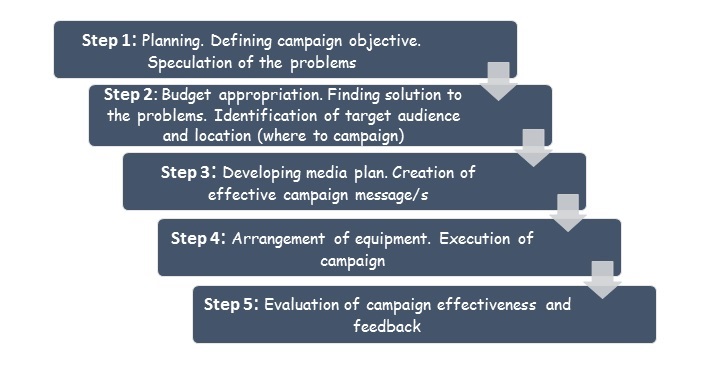
Check Your Progress
- What is campaign?
- How is a campaign beneficial for the products/services promotion?
- What do you understand by ‘an effective campaign?’
- What are the steps of campaign process?
Advertising Research
- Why do consumers prefer some brands over the others?
- What makes them choose, buy, and invest in some product/service over others?
- What are the things/barriers or motivation to do so?
- What is the perception of target audiences?
- Does advertisement really change consumers’ behavior?
There are many questions of such kind that you need to think over, again and again before advertising your product/service. But the question is how will you get the answer? Answers to all these questions can be got through “Research.”
What is Advertising Research?
Advertising Research is a scientific technique of depth analysis of consumers’ behaviors.
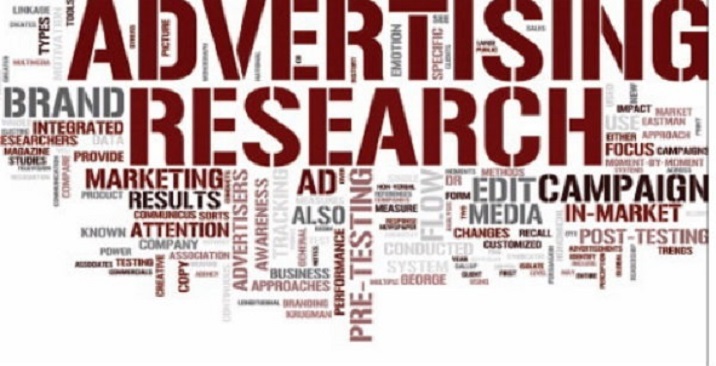
It is done through a process, which involves systematic gathering, recording, and analysis of data related to the effectiveness of an advertisement.
Objectives of Advertising Research
- To Enhance Awareness − Through research, it is easy to plan the marketing strategy of any product/service.
- To Know Attitudinal Pattern − A thorough research predicts the people’s attitude. It analyses the changing attitudinal pattern of a geographic area. Knowing the consumers’ attitude is very important before launching a new product and its advertisement.
- To Know People’s Action/Re-action − Research also records and analyzes people’s action or re-action regarding a particular product/service.
- Analysis − Based on deep research and analysis, it is simple to design and develop a creative ad, effective enough to influence consumers.
Essentials of Advertising Research
Following are the essentials of advertising research that support researcher to complete the research task successfully −
- Research Equipment − It is the basic requirement of advertising research. It includes a skilled person, computer system with internet, and relevant newspapers and magazine. However, field research is also important. For example, interviewing people in the market or their residential places.
- Media Research − To determine, which media is the most effective advertisement vehicle, media research is necessary. It helps to reach the potential customers in a short period of time and at lower cost.
- Marketing Trends − Knowledge of marketing trends help advertisers to know what products people are buying and what are the specific features of the products, which compels people to buy. With this information, manufacturers can modify their product according to the trend on competitive price.
- Target Audience − For any advertising research, it is very important to identify target audience and geographic location.
Benefits of Advertising Research
Conducting research before launching a new product and subsequently developing an ad has the following advantages −
- Develops creative design and strategy − Once, all information is available, it is very simple to develop an eye-catching design. It also helps in making a well-defined strategy to develop your business.
- Identifies Opportunity in the Market − Research suggests — what is the right time to launch the product. It also tells, which geographical location is the best for the product.
- Measures Your Reputation − It is always beneficial to know your competitor’s reputation and credit in the market. It helps to develop faultless strategy.
- Identifies Major Problems − Research helps to identify the potential problems.
- Analyzes Progress − It helps to analyze the performance of your product. Likewise, you can monitor your progress.
- Minimize the Risk − If you have done a thorough market research, there is least chance of failure.
Check Your Progress
- What is an advertisement research?
- Why advertisement research is important for an advertiser?
- What do you understand by a ‘media research?’
- What are the benefits of an advertisement research?
Advertisement Copywriting
“Baat karne se baat banti hai”“Built For The Road Ahead”
What does come in your mind? Remember, where did you hear these captions?
The first one is “Airtel,” Second belongs to “Ford”.
Some punchlines are eye-catching and grab attention at the very first time. Why?
It is because of the fascinating words that are used and arranged in a creative way. This chapter discusses the techniques of creative copywriting without creating an issue of copyright.
What is Copywriting?
Copywriting is the skill of choosing the right words and technique of arranging them smartly to promote business, product, service, idea, or a person. The selection of words and its presentation largely depends upon the media through which it is planned to convey. For example, depending on whether it is a newspaper, magazine, hoarding, radio, television, or internet, the script will vary accordingly.
However, whatever is the type of media, the purpose of copywriting is the same i.e. promotion. Therefore, it should be persuasive enough to be instantly attention grabbing.
Elements of Copywriting
Copywriting has some essential elements required to develop a convincing ad. Following are the significant elements −
- Heading − Headline gives the first impression and lasts on readers’ mind, therefore, it should be eye-catching. Heading should tell – what it is all about your ad in a very few words, ranging from 3 to 30 words.
- Body copy − Write body copy in such a way that it seems as the continuity of the heading. Provide details of all the features and benefits that you are claiming for. The language should be promising and trustworthy.
- Slogans − Think of "The ultimate driving machine" (BMW); “Just do it” (Nike); "Because I'm worth it" (L'Oréal), what comes to your mind? The moment, you hear the slogans, you link it with the respective brand not only because you have heard it many times, but rather it works. A well-written and effective slogan is a trustworthy brand representative. However, your slogan should be small and crispy giving meaning to your brand.
- Taglines − Taglines are usually used for literary products to reinforce and strengthen the audience's memory of a literary product. For example, “she went in search of answers, and discovered a love she never expected,’ Book Name “Faithful” and Writer - Janet Fox. Thus, tagline tells the gist of the products for marketing purpose. Like, a slogan, it should be small and eye-catching.
- Jingle Lyrics − More often accompanied with background music, iingle lyric is a short slogan, tune, or verse written to be easily remembered (especially used in advertising). For example, Fanta: "Wanna Fanta, Don’t You Wanna?" It should be small, crisp, and rhythmic (like a song) so that it registers with people at once and they remember it.
- Scripts (for audio and video ad) −Scripts are the descriptions of an ad that narrates the dialogues, actions, expression, and movements of characters. Since, script is a complete guidelines of an ad; therefore, it should be written meaningfully, orderly, and nicely.
- Others − (White Paper, Press Release, & other written material such as emails, articles, and blog (for the internet)): These are all promotional write-ups written purposefully to promote a particular product/service. So, while writing white paper, press release, articles, blog, or even an email you need to focus or emphasize ONLY on one product that you want to promote. You need to describe all features and offers of the respective product in simple and plain language.
Art of Copywriting
The basic purpose of an ad is to fascinate people. Only after catching people’s attention, an ad arises interest and desire to buy the product. Therefore, it should be an eye-catching and interesting. Copywriters play a very important in the advertising industry, as they are the ones to choose the right word or phrase to connect with the audience.
Copywriting is the art of creative and persuasive writing that goes a long way to sell the product or an idea. One of the most traditional, but successful techniques of copywriting is “AIDA” i.e. Attention, Interest, Desire, and Action.
Copywriting Techniques
Following are the techniques of persuasive copywriting −
- Use Action Words − Such as watch, look, ask, get, etc.
- Use of Buzzwords − Normally, buzzwords are eye-catching such as now, today, etc.
- Use Exciting or Emotive words − Such as amazing, wonderful, beautiful, etc.
- Use Alliteration − Use meaningful words of similar sound. For example, Don’t be vague, ask for Haig.
- Use Colloquial words − Colloquialisms in copywriting is pretty popular and effective. For example, ‘Pick ‘n Choose.’
- Use Punctuation − Proper use of punctuations and grammar is an important aspect so that you can pass the right message.
Pay Attention while Writing Headlines
- Try to keep headline as small as possible (5 to 10 words are ideal).
- Use meaningful and striking words to make heading persuasive.
- Try to use brand name in the headline.
- Stick with the typeface in a headline.
Pay Attention while Writing Subheading
- Subheading should support the headline.
- It should be appealing so that the reader is impressed to read the body copy.
- Use minimum, but meaningful and fascinating words in subheading.
Pay Attention while Writing Body Copy
- Try to keep the sentences in present tense.
- Use simple and familiar words.
- Keep the sentences small, and do not lose the link between the sentences.
- Use singular noun.
- Use active verbs.
- Convey message as if it is a new information to grab attention.
- Avoid using clichés and superlative words.
Protect Yourself From
- Using any vague word or sentence.
- Using many adjectives.
- Copying any others’ sentences (Copyright issue).
- Using unfamiliar words; your target audiences are not language expert.
- Be honest; do not promise something, which is not there.
- Do not use too many words (avoid wordiness); you have limited space.
- Your message should not be violating anyone’s right or feelings; you have to be honest and true.
Check Your Progress
- What do you understand by copywriting?
- What is copywriting technique?
- What are the elements of copywriting?’
- What do you need to avoid while copywriting?
- What do you understand by the ‘art of copywriting’?
Advertisement Portfolio Presentation
Suppose, you are a well-qualified professional having more than five years of experience and have worked on various projects — how do others come to know about this?
Your employer or your client needs to know about your skill sets supported with the projects that you have done. The simplest and preferable way to showcase your skills and let people know about it is to create a portfolio.
What is a Portfolio?
A portfolio is a wholesome and integrated information about an individual or a company. It showcases qualifications, skill sets, and work experiences on a piece of paper. It is a succinct write-up presented with some fascinating graphics, charts, and images.
A portfolio is an opportunity that offers you space to plan and reflect the best of your practice. It represents in-depth information, helping you identify your strengths and find ways to build a career on it.
Portfolios are developed for different purposes and its content and presentation vary accordingly. However, the most common portfolio that most of us need is professional portfolio.
Design of Portfolio
Design is the most important feature that you need to pay attention to while developing a portfolio. Secondly, you have to showcase everything in a limited space. Hence, your design has to be creative to include text, graph, images, and other artifacts.
Following are the significant features that you need to take care of while creating your portfolio −
- Customize your templates as required and as suitable for you.
- Represent each project or chapter with a thumbnail image.
- Select standard font as preferred for the portfolio.
- Select small, but high resolution images.
- Arrange in chronological order, but it has to be synchronized.
- Highlight your strength and hide your weaknesses.
- Be creative because there is no standard format of a portfolio that suits everyone and is applicable for all purposes.
Based on types of portfolio, purpose of portfolio, and individual’s skill sets, it varies accordingly.
Contents of Portfolio
A well-organized and eye-catching portfolio includes the following points −
- An index page.
- A brief bio-data including your interest and proof of your skill sets.
- Key achievements.
- Examples of your works, put it in chronological order with synchronization. Highlight important ones with example.
- Skills that show your thought process and development of ideas, etc.
Common Mistakes of Portfolio
Following are the common mistakes that you need to avoid while creating your portfolio −
- Important, but Irrelevant Information − Be specific. Shortlist the important points first.
- Too much Colorful Design − Avoid using too colorful designs.
- Low Resolution Images − Do not use low resolution or poorly printed images.
- Excessive Information − Do not give excessive information regarding anything.
- Size of Portfolio − Keep a standard size, do not make it lengthy and boring.
- Space Management − Use standard and balanced font size, font color in proportion to space and images. Maintain balance on the page.
Check Your Progress
- What is portfolio presentation?
- Why is design important while making a portfolio?
- What are the important points of a portfolio?
- What are the common mistakes of a portfolio?
Advertising Agency
Do you know – What does a tailor do?
As a tailor’s job is to design a piece of cloth as per your choice; similarly, an ad agency designs your ideas into a complete audio or/and video ad tailored to your requirements.
Similarly, an advertiser gives an idea to an ad agency and in return ad agency returns back a fascinating ad.
What is an Ad Agency?
An ad agency is a service organization, specialized in planning, development, management, and execution of advertising program for the clients.
Making an ad is a lengthy process that involves experts from various fields. Ad agencies are usually independent firms offering qualitative work and assisting organizations or individuals to reach their target audience through their eye-catching audio/visuals. An ad agency plans, creates, researches, manages, and executes ad on different media platforms for the advertiser.
Functions of an Ad Agency
An ad agency has wide range of functions starting from the materialization of an idea, the commercialization of a new product/service to development of healthy public relation. However, some of the significant functions of an ad agency are −
- To take the advertiser’s idea/message and transform it into an effective and memorable communications.
- To increase sales.
- To provide an integrated, professional, and quality services.
- To accelerate the economic growth and create public awareness.
- Gathering feedback given by the customers and other audiences for the future improvement.
Importance of Ad Agency
An ad agency offers an integrated solution under one roof to its clients (advertisers). It has qualified professionals, who are experts in their respective fields. For example, copywriters, jingle writers, planners, researchers, videographers, managers, etc.
The following salient features make an ad agency important −
- It has great social contacts and huge networking.
- Makes optimum use of every resource.
- Provides quality work.
- Saves cost to great extent.
Types of Ad Agency
Based on function and size, following are the most common types of ad agency −
- Full Service Agency − It is a bigger firm having whole range of advertising and marketing solutions.
- Interactive Agency − It is a smart ad agency using all latest digital technology. It offers pretty creative and interactive ad solutions.
- Creative Boutiques − A smaller sized firm specialized in creative ad services.
- Media Buying Agency − These sort of agencies buy and manage places for the advertisement and other sort of campaigns. It also manages the time schedule with the media to place the ad and supervises the ad to see if it is broadcasted properly on time or not.
- In-House Agency − It is a full services agency, usually in-built and works as per the needs of the organizations.
Services Offered by an Ad Agency
An ad agency provides a whole range of advertisement and marketing solutions. Important of them are −
- Integrated Ad Service − Provides services starting from strategic planning, creative designing & development, profound research, and media selection to execution.
- Integrated Media Service − Offers services for both advertisers as well as for media including print media, electronic media, and digital media. It is a medium between advertisers and media.
- Marketing Services − Provides a range of marketing solutions including advertising, sales promotion, campaigning, market research, event marketing, public relations, and many more.
- Content Services − Provides content for all sorts of events, TV program, animated content, and for entertainment as well.
- e-Solution − Provides whole range of e-solutions. For example, system integration services, search engine marketing, e-business consulting & customer relation management, e-sales promotion, etc.
- Integrated Branding Service − Ensures advertisers and its clients receive branding service of the highest quality.
Check Your Progress
- What is an advertisement agency?
- How does an advertisement agency help advertiser to grow his business?
- Define various departments of an ‘advertisement agency.’
- What are the functions of advertisement agency?
- What do you mean by specialized agency?
Advertisement - Code of Ethics
“Mr. ‘X’, a celebrity, has served notice for giving false and arbitrary information in ‘y’ ad …”“Advertiser is sued because of broadcasting absurd or disrespectful ad …”
These sort of news we hear every now and then. More often, to increase the sell and achieve success in short span of time, some of the businesses/individuals make false promises, use unethical words, or claim oneself to be better than their competitors. All these acts are illegal.
Therefore, to avoid disputes or discrepancies, it is necessary to promote reasonable and fair competition, and protect everyone’s right, dignity, and integrity. For this to happen, rules of advertisement is legislated.
What is Code of Ethics for Advertisement?
Code of Ethics define the legal as well as ethical rules and norms of creating and broadcasting an ad. It restrains an advertiser to promote any product/service through unreliable, false, and immoral information.
Such kind of language and information may damage someone’s fundamental right, business reputation, and can stain their honor and dignity. So, the law prevents any sort of ad that infringes on public values, norms, and morality.
Further, it also discourages creation of any sort of ad that contains disrespectful comparison with other similar products (either of same nature or different) to maintain fair competition.
Purpose of Code of Ethics for Advertisement
While dealing with an advertisement, the most important point that you need to take care is — you need to develop a healthy, promising, and long-lasting public relationships.
The purpose of code of ethics is to maintain fair competition and protect the right of every individual. Code of ethics help advertisers set ethical standards to govern the ways of communication and develop self-regulatory ads. Ethical norms of advertising restrict ads that make false claims and are not within the normal standards of decency.
Legality of Advertisement
The following type of advertisements are considered as illegal/immoral and prohibited by the law −
- False or Misleading Information − Any ad must not contain any sort of claim, which is false, deceptive, or ambiguous to public. It includes false promises, partial truth, exaggerated commitment, false price, etc. It is important to know that such kind of content is not limited only to verbal or written claim, but rather it is also applicable to images, video, and other sort of demonstration.
- Inaccurate Testimonials − When a person gives his opinion or talks about his experiences regarding any product/service, he must not give fake information. Law discourages false and deceptive testimonials.
- Provoking Statements − Any sort of statement, insulting phrase, immoral comparisons, etc. is prohibited. Insulting phrase includes any sort of disrespectful comment regarding a race, nationality, profession, cast, sex, social background, age, religion, language, etc.
- Offensive Materials − All material used in an ad such as verbal and textual communication, audio, video, and images must be decent for the general public. Any material used in an ad, which is offensive, obscene, or indecent to the common people is outlawed as per the Standards of Practice.
Consequences of Broadcasting Unscrupulous Ad
If someone violates the code of conduct and disseminates unscrupulous ad by any means shall be liable to damages caused by the immoral or unlawful ad. He may be punished and ordered to pay −
- A compensation amount (fixed by the court of law) equal to the harm done by him to the wealth, health, or life of a person or to any other legal entity.
- A compensation for moral damage.
- A compensation for all sort of losses.
“THE CODE FOR SELF-REGULATION IN ADVERTISING PERTIENT EXRACTS” was adopted by “The Advertising Standards Council of India” in November 1985 under the Article 2 (ii)f of its Articles of Association. Further, it was amended in 1995 and 1999.
Check Your Progress
- Why does advertisement need Code of Ethics?
- Describe any case under which advertiser has been punished for violating the rules.
- What do you understand by ‘offensive materials’ in advertisement?
- What are the consequences of unscrupulous advertisement?
Marketing Communications - Introduction
Suppose you manufacture a product to sell, then how would you reach out to your potential customers?
Until people come to know about your product, you cannot sell it. So, to popularize your product, you need to communicate with people. Today, there are various techniques of communication that helps market a product, improving the product reach and optimizing business performance.
What is Marketing Communication?
Marketing communications are those techniques that the company or a business individual uses to convey promotional messages about their products and services. Experts of marketing communication design different types of persuasive communication and send it to the target audience.
What are the Marketing Communication Tools?
There are different tools used to attract the target audience. However, which tool to use depends on various factors such as geographical location of your target audience, popularity of your products, etc. Following are the important tools popularly used for marketing communications −
- Pamphlets
- Brochures
- Emails
- Advertisements
- Websites
- Sales Promotions and Campaign
- Exhibitions
- Personal Selling
- Press Release
Why is Marketing Communications Important?
The sole purpose of marketing communications is to increase the volume of sales by persuasive, informative, and positive messages. Marketing communication provides new facts through encouraging messages about products/services.
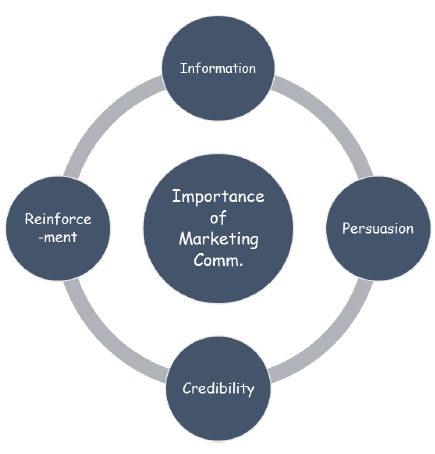
Marketing communications is meant to inform and persuade target audience and reinforce market credibility.
Marketing Communication Process
Communication simply means passing the information from the sender to the receiver. But in practice, this is a complex process that involves many other factors. However, Kotler has given one of the most effective models to define the marketing communication process (see the following diagram) −
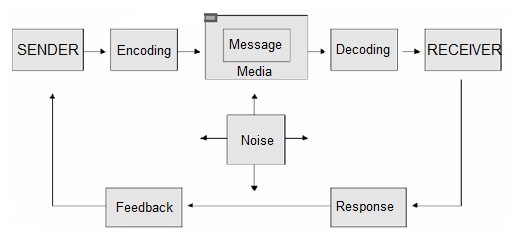
The diagram explains various components − first two components are ‘sender’ and ‘receiver’. Second two components are ‘message’ and ‘media.’ The other features of this model are ‘encoding,’ ‘decoding,’‘response,’ and ‘feedback.’ And, the last feature is ‘noise.’ Noise is random and other competing messages that more often interfere with the communication.
This model emphasizes on the major key factors that play an important role in effective communication. It is imperative to know the market response and your target audience before you send any message.
Tips of Effective Marketing Communications
Following are the important points that you need to take care of for effective marketing communications −
- Persuasive Message − Different customers have different requirements and expectations; therefore, it is very important to customize your persuasive messages accordingly.
- Design − Every medium of communication (such as magazine, newspaper, TV, digital media, or brochure) has its own design and requirements. Therefore, you need to plan and design your messages accordingly.
- Feedback − Must collect feedback from your audience; it will help you improve your marketing communication.
Marketing Communication Mix
Generally, marketing communication mix is an integrated term that includes personal selling, direct response marketing, sales promotion, media advertisement, and public relations. These are the tools associated with strategic activities to communicate with the target audience.
The following table illustrates the common platforms of Marketing Communication mix −
| Sales Promotion | Personal Selling | Advertisement | Public Relations |
|---|---|---|---|
| Programs | Sales meetings | Print media | Speech |
| Game, Contest, Lotteries, Coupons etc | Sales Presentations | Electronic media, Motion pictures | Press Release, Seminars |
| Gifts, Sampling | Incentive programs | Brochures, Booklets, Magazines, etc. | Charitable donations, Lobbying |
| Exhibition, Trade shows, Offers | Exhibition, Trade shows, Offers | Billboards, Displays, etc. | Sponsorships |
| Low interest financing | Brochure, mailing, etc. | Logos, Symbols,etc. | Publications, Company magazine, etc. |
| Rebates | Digital shopping | Audio & Video materials | Community Relations |
| Entertainment | TV shopping | Point-of purchase display | Events |
Check Your Progress
- What is marketing communications?
- Why is marketing communications important?
- Define marketing communications process.
- What do you understand by an effective marketing communications?
- Describe marketing communications mix.
Strategy & Planning
“Strategy without tactics is the slowest route to victoryTactics without strategy is the noise before defeat.”− Sun Tzu
What is a Strategy?
Defining marketing communication strategy is not an easy task because it depends upon different distinct variables. It is planning and integration of all communication tools for a single purpose. In 1997, Smith et al defined marketing communications strategy as −
“The message or sequence of messages which should be shared with specific target audiences through the optimum communications mix.”
Features of Marketing Communications Strategy
Before you make a strategy, you need to consider the following three points suggested by Micael Dahlen et al (2003) −
- Target Audience − Whom are we trying to reach
- Persuasive Message − What do we want to say to them
- Channel − How are we going to say it
Marketing Communications Strategy Process
To make a well-planned and result-oriented strategy, you need to follow a strategic process. The following diagram illustrates the important components of marketing communications strategy process −
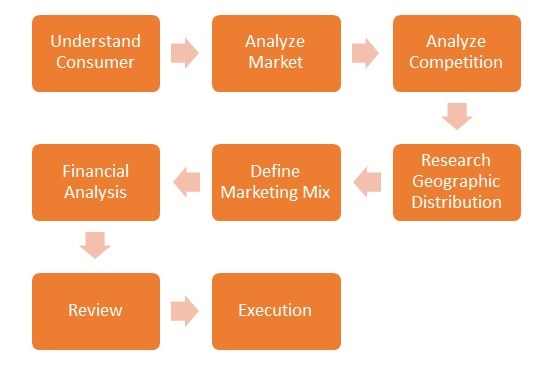
Marketing Communications Planning
Planning and strategy is pretty confusing terms and many times used interchangeably. However, the most significant difference between them are — planning is an internal problems and strategy is the external problemsof the company. Secondly, planning supports strategy to get accomplished. The following diagram illustrates the Marketing Communication Planning −
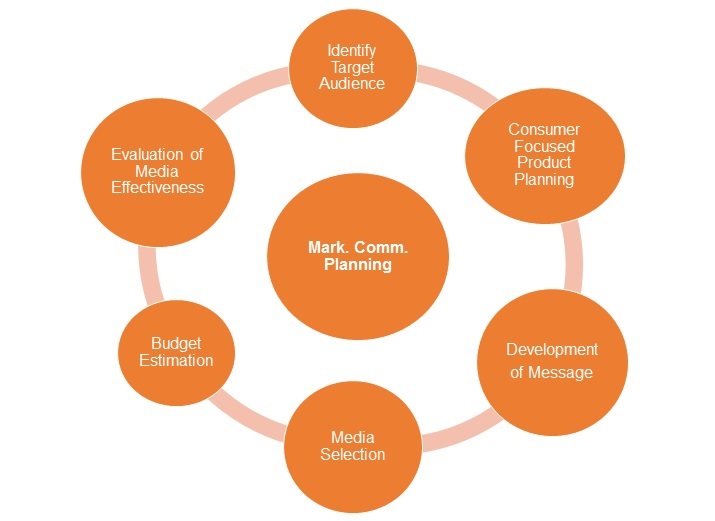
Changing Trend of Marketing Communication
Today, the trend of advertisement and marketing communication has changed. Many of the companies including Adidas, Nike, Coca-Cola, etc., are putting more emphasis on digital marketing.
For example, as per the report − Nike’s new future campaign strategy is “Competition via Social Media.” Nike has reduced the budget of its traditional marketing by 40%. Its new strategy is to target group audience in the 15-25 age group through social media.
Another example is that of Adidas. The main strategies of Adidas group are −
- Diverse Brand Portfolio
- Investments Focused on Highest-Potential Markets and Channels
- Creating a Flexible Supply Chain
- Leading Through Innovation
- Develop a Team Grounded in our Heritage
- Becoming a Sustainable Company
Check Your Progress
- What is the difference between strategy and planning?
- What is the difference between strategy and planning?
- Define various features of marketing communications planning.
- Define the new strategy of big brands.
Integrated Marketing Communications
Many of the companies in 1980s rather than relying only on advertisement adopted an integrated strategy. They combined various promotional tools and marketing activities to communicate with their target audience. Their integrated strategy worked as they expected. Later on, it became the trend.
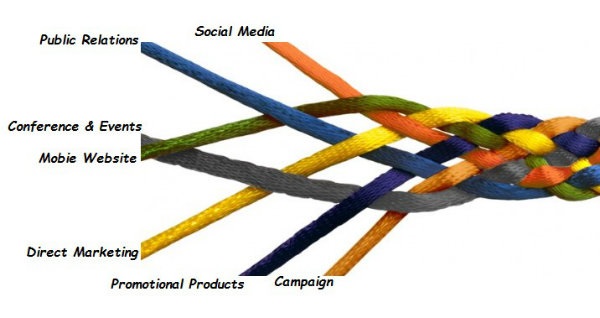
Components of Integrated Marketing Communications
The following diagram illustrates the major components of integrated marketing communications −
Integrated marketing covers a wide area and includes the following elements −
- Ad − An ad has a very important role that increases the visibility of your products on a very large scale.
- Social Media − Social media (such as Facebook, YouTube, etc.) is a tool/medium to promote your business.
- Employee Branding − A reliable employment brand is one that nicely communicates the culture, mission, and values of your company and gives people a compelling reason to want to work for – and stay with your company/organization. Today, all companies practice employment branding technique.
- Conference and Events − Conference and event are the activities, which are organized on specific time and at specific place for brand promotion. Organizing company primarily sends invitations to potential audience and also advertises it through different media channels to invite maximum people to participate in the conference/event.
- Corporate Responsibility − Corporations have a responsibility to those groups and individuals who can affect their business. For example, stakeholders (e.g., employees, customers, suppliers, communities, etc.) and society at large. Therefore, corporate responsibility suggests that corporations need to be consistent with ethical principles and conduct such as honesty, respect, and integrity with all stakeholders.
- Affinity Marketing − Affinity marketing is a sort of social bonding with other organizations and customers who share the same interest. This act increases brand loyalty for both companies and products and promotes market awareness.
- Partnership − Partnership, simply means, an association of two or more people/companies/organizations. More often two people or companies agree to work in partnership for a common goal.
- Financial Communication − The purpose of a financial communication is to bridge the gap between the investment decisions makers and financial experts necessary for the financial transactions.
- Public Relation − Public relation is an important technique that establishes a friendly relationship between a company or organization and the public.
- Direct Marketing − Direct marketing is the technique to sell products/goods directly to the customers through different medium. For example, through mail, telephone, etc. Retailer has no role in direct marketing.
Check Your Progress
- What is integrated marketing communications?
- Define various components of integrated marketing communications.
- What do you understand by a campaign?
- Give an example of direct marketing.
Interactive Marketing
Technological revolution has brought about dramatic changes in terms of volume, frequency, and effectiveness of marketing communications. The increasing trend of internet technologies has given way to interactive marketing. The internet hosts human dialogue, in a way that influences thousands of audiences at the same time.
What is Interactive Marketing?
Interactive marketing is simply an extension of direct marketing by using advanced technologies. Interestingly, it offers two-way communications between the seller and the buyer. Interactive marketing is also popularly known as “Digital Marketing”. Troy Sabin beautifully explained the interactive marketing through the following diagram −
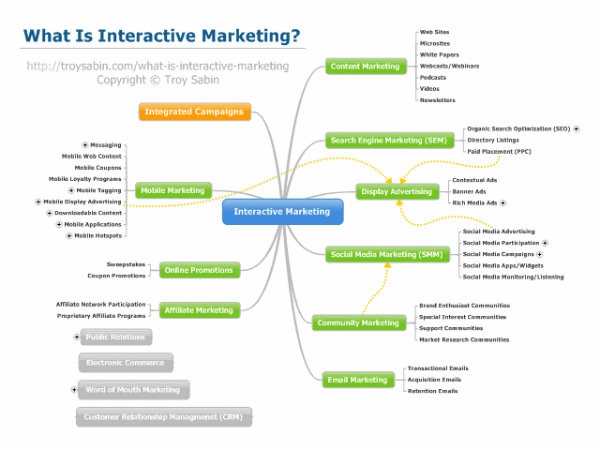
The advantage of interactive marketing is that it precisely communicates with the individuals/audiences and can easily customize the message, which is relevant to consumers.
Examples of Interactive Marketing
In the present world, interactive marketing is on everyone’s fingertips. For instance, shopping is just a few clicks away either on a computer or on a mobile.
Following are some of the most important platforms that offer interactive marketing solutions: www.amazon.com, www.flipkart.com, www.ebay.com, etc.
Check Your Progress
- What is interactive marketing?
- Give some real-life examples of interactive marketing.
- Define the various platforms of interactive marketing.
- Share your experience of online shopping.
Market Communications Research
In today’s world, if a company focuses on delivering good products/services at competitive prices, it does not necessarily guarantee success. Modern marketing system has various distinct components that need to be taken care of. And, it is possible only by thorough “Research”.
What is Marketing Communications Research?
Research is a technique of collecting, compiling, analyzing data, and based on that finding a solution for effective marketing communications.

Marketing communications and its management involves several issues that more often restrains the marketing communications process. So, to develop a well-planned strategy, research is the only solution for the successful marketing communications.
Objectives of Research
The main objective of research is to understand the type of messages that will work for your company and develop a strategy to execute both in the domestic as well as global markets. Effective and persuasive messages said at the right place and at the right time motivates consumers to take action.
Therefore, research normally helps you −
- Design a persuasive message − what are the optimal messages for your products/services? How can it be delivered? What are the supporting components that can potentially help make your marketing successful?
- Receive Feedback − Through research, you can come to know about the feedback of your audience, which is imperative to improve your communications.
- Develop a Model − Based on consumers’ actions and/or reactions, you can develop a model for effective marketing communications.
Check Your Progress
- What are the techniques of market research?
- Why is market research important?
- Define various challenges of market research.
- What do you understand by design persuasive message?
Corporate Communications
“Communication leads to community, that is, to understanding, intimacy, and mutual valuing.”− Rollo May
What is Corporate Communications?
Corporate Communications is a technique that involves all communication activities generated by a company to achieve the planned objective.
Corporate Communications is an important activity because it creates strong and appealing ideas, views, and position on which a company can rely. Ultimately, it helps to grow your business.
How Does Corporate Communications Work?
Corporate Communications works through −
- Organization − Need to harmonize the internal and external activities of the company.
- Management − Need to manage the company’s communications with its own employees and audience/customers.
- Marketing Communications − Development and application of strategic marketing communications.
Types of Corporate Communications
Normally, Corporate Communications is categorized as −
- Internal − It includes employees, Stakeholders, etc.
- External − It includes agencies, channel partners, media, government, educational institutions, general public, etc.
Tools of Corporate Communications
Following are the tools of Corporate Communications −
- Company Logo
- Company Design (including fonts and typefaces)
- Company stationary (e.g. letter heads, visiting cards, greetings, etc.)
- Internet Branding
- Code of Conduct (including HR conduct)
- Customer relations
- Rewards, appraisals, and recognitions
- Advertisement, campaign, direct marketing, etc.
- Site signage
- Personal and commercial vehicle branding
Responsibilities of Corporate Communications
Corporate communications has the following significant responsibilities −
- Management of corporate communications
- Practical corporate communications planning
- Dealing with internal and external audiences
- Dealing with the media
- Persuasion and dissemination of corporate information
- Brand management
- Monitoring and regulation of market and audience responses
- Crisis management
- Giving advice to employees and executives
- Dispute resolution
- Coordination with the stakeholders and other overseas customers/clients
Marketing Communications vs. Corporate Communications
The following table illustrates the differences between Marketing Communications and Corporate Communications −
| Marketing Communications | Corporate Communications |
|---|---|
| It has customers | It has multiple stakeholders |
| It is defined by a set of channels | It is defined by the multiple channels |
| It emphasizes on a product or service | It emphasizes on the whole organization |
| More creativity | Less creativity |
| Communication is controlled | Variety of communications |
| It is required to be consistent with the product/service attribute | It is required to be consistent with corporate identity |
Check Your Progress
- What are the works of corporate communications?
- What do you understand by corporate communications?
- Define various responsibilities of corporate communications.
- What are the differences between marketing communication and corporate communications?
Brand Management
While shopping or planning to shop, many of us are stuck with a particular brand. For example, I wear only Woodland shoes, I buy only Blackberry trousers, I like only Apple laptop, etc.
So, what is this likeness and rigidness? Why are we so particular with a certain brand? This chapter tells what a brand is and what its importance is.
What is a Brand?
Brand is the name and credibility of a company in the market. A big brand evolves through substantial period of time with consistent and regular quality production and services. Brand name keeps your customers committed to your products/services.
A credible brand name helps customers to identify quality product and differentiate with other. It reduces customer’s perceived monetary and safety risk while buying the products/services. For example, the services of British and Emirate Airways, unmatchable design of Lamborghini, etc.
What is Brand Management?
Brand management is something that begins with the thorough knowledge of the brand. It involves with making a promise and maintaining that promise.
In other words, brand management is a technique of improving and maintaining the credibility of the brand through quality product and prompt services.
Brand management manages both the aspects i.e. tangible such as quality of products, packaging, price, etc., and intangible, which includes the emotional connections with your products/services.
Salient Features of a Brand
A good and reputed brand should have the following salient features −
- It should be creative and distinctive, e.g., Apple, Maybach Exelero, etc.
- It should be a recognition of the product’s qualities and services, e.g., for quality services − Emirates Airways, etc.
- It should not have wrong interpretation or mismatch with the product, e.g. “Feo” is not good brand name for the cosmetic product. It is a Spanish word, meaning ugly.
- It should be easily accessible in foreign countries.
Brand Attributes
Brand attributes basically suggest the brand characteristics. It highlights physical as well as qualitative aspects of the brand, which is developed through quality, image, actions, customers’ satisfaction, etc.
A big and popular brand carries following attributes −
- Relevancy − Any good and strong brand must be relevant and perform well or give results according to people’s expectations.
- Uniqueness − It must be unique and creative enough to catch the attention of the people in the market.
- Sustainable − It must sustain in a competitive market.
- Consistency − It must be consistent in the market to build customers’ trust. The company should always stick with the quality and theme that it conveys to its audience.
- Credibility − To develop the credibility, a popular brand should always fulfil its promises. The promise and quality of product must be the same.
- Appealing − It should must be appealing enough to convince people.
Branding Process
Branding process involves a few steps illustrated in the following image −
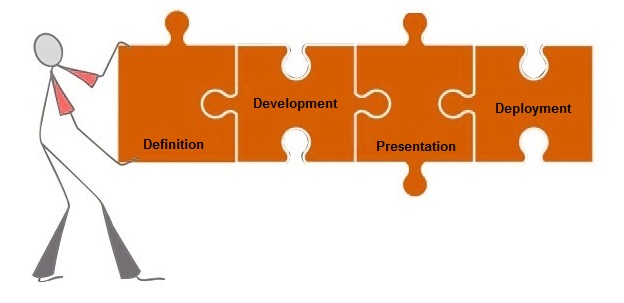
As shown in the above image, first you need to define the idea as it will help you to develop into reality. After the ideas takes shape, then comes presentation. Presentation is a sort of internal review. It helps you correct any errors before deployment.
Brand Positioning
Brand positioning is a marketing technique, which is developed for a common objective, i.e. to create a stronghold in the market. The technique aims at occupying a place in the customer’s mind and providing compelling reasons to buy; it emphasizes on establishing a healthy relation with customers.
Further, it ensures your brand is distinct and unique in comparison to competitors and helps the company to meet the target.
Check Your Progress
- What do you understand by brand?
- What do you understand by brand management?
- Define attributes of brand management.
- What do you understand by brand positioning?
- Describe branding process.
Marketing Vs. Advertising
Many people confuse the terms marketing and advertisement. They think, both are the same and used interchangeably. But there are distinctive differences between the two. This chapter describes the difference between marketing and advertisement.
However, to understand the differences between them, let us discuss it one-by-one −
What is an Advertisement?
Advertisement is a technique to create awareness about a particular product/service to the existing and new customers. One advertisement promotes only one product/service. Every ad has to be unique and creative. For example, advertisement of a soap must be different from the advertisement of a cold drink.
An ad uses the following mediums −
- Print Media − For example, newspaper, magazine, etc.
- Electronic/broadcasting Media − For example, radio, tv, internet, etc.
- Outdoor Media − For example, hording, flyers, billboard, etc.
What is Marketing?
On the other hand, marketing is a comprehensive term that involves many other activities including advertisement. Some of the important activities of marketing are −
- Planning
- Developing Strategy
- Research
- Public Relations
- Advertisement
- Budgeting
- Customer service
- Feedback and Analysis
The following image summarizes the comparison between Marketing, Advertising, Public Relations, and Branding −

Check Your Progress
- What do you understand by marketing?
- What do you understand by advertising?
- How is marketing different from advertising?
- Make a list giving examples of advertisement and marketing that you observed in your city.
Contemporary Issues
Offer, presentation, campaign, advertisement, sales promotion, public relations, etc. are the trends of advertisement and marketing communications. There is nothing wrong in these types of communication unless they do not portray a wrong image, convey unethical message or harm the reputation of an individual/firm.
What are Contemporary Issues?
Issues related to advertisement and marketing communications are largely categorized as −
- Ethical Issues
- Social Issues
- Legal Issues
Let us discuss each of them in detail −
Ethical Issues
Ethical issues involve the ‘right’ and ‘wrong.’ It is moral conduct related to advertisement and marketing communications. For example −
- Puffing − If someone sells his products by using vague or exaggerated messages, which are literally wrong, then this is morally not acceptable. For example, a motorcycle seller claims that his motorcycle’s mileage is 90km/liter and practically that motorcycle gives only 65km/liter.
- Deception − If a seller makes you believe something, which does not exist in reality to sell his products is deception. For example, in advertisement, it is shown that buy one get one free, but once you approach the shop, you come to know that the item is pretty expensive and the free item is useless.
- Advertising to Children − Children are the easiest prey for sellers these days, which leads to child-parent conflict and sometimes there are chances that children take a wrong stance.
- Advertisement of Controversial Products − In some of the countries including India, advertisement of products such as tobacco, alcohol, drugs, and even gambling is not allowed. It is not only unethical, but also illegal.
Social Issues
Social Issues involve the following points −
- Predatory Pricing − Offering lower price by the multinational companies, it is unsocial because it can wipe out the local products and create employment in the country.
- Surrogate Ad − Advertising the banned product in subtle means, e.g., advertisement of alcohol, cigarette, etc. in India where ad of these products are banned.
- False and Misleading Ad − Comparing with the rivals. More often you see in the magazine and newspaper, some of the companies such as car companies, electronic gadget companies, etc., give detailed comparison, and show their product is the best. Further, they also give experts’ opinion to show their superiority.
- Intrusive Promotions − Persuasive and unwanted messages sending on common men’s cell phone. Further, unwanted calls on your cell phone, etc., are the big social issues.
- Post-purchase Dissonance − To sale the products, companies promise everything, but once you purchased and encounter issue, the respective seller is reluctant to entertain you.
Legal Issues
Copyright, Trademark violations − Copying others content, design, name, etc., are the common legal issues.
Morally, socially, and legally, all these issues are not acceptable and a great nuisance of the society. Governing and regulatory body must look into the matter to wipe out these issues sincerely.
Check Your Progress
- What are the contemporary issues?
- What do you understand by ethical issue?
- Define various social issues.
- What do you understand by legal issues?
- Give an example of a legal issue that was in news recently.



Comments
Post a Comment